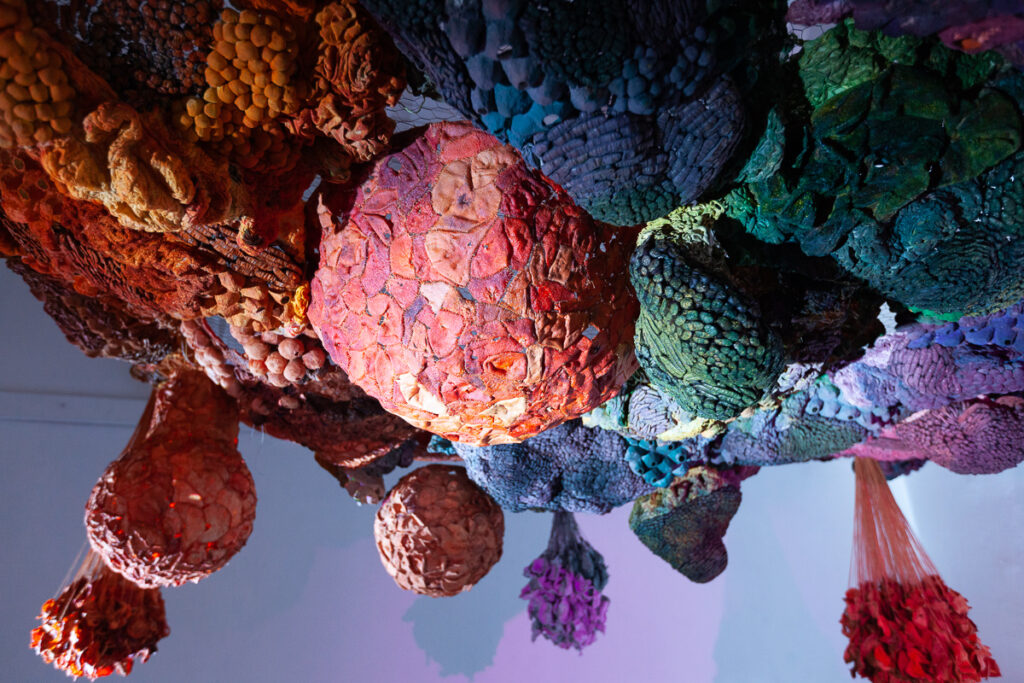
Biomater, 2021, Clarisa Menteguiaga, Liliana Ojeda, and Paulina Villalobos; fruit peel, seaweed, cotton thread, vegetable pigments, corn textile, recycled cardboard; dimensions: 1 mt x 3 mt x 2,5 mt
Catalina Mena reflects on the exhibition in Chile by Clarisa Menteguiaga, Liliana Ojeda, and Paulina Villalobos, which witnesses the beauty of decay in the gallery.
From its title, Biomater refers to an imaginary of the origin, leading us directly to nature. But it is not only a retinal landscape that this work puts on stage but the inescapable manifestation of living matter. The work turns our attention to the organic world that surrounds us and which we have neglected.
Biomater reflects on the need to protect the natural environment, and does so from its own structure, constituting itself only from biodegradable materials. For this reason, this installation in its entirety is also susceptible to being affected by the passage of time, to gradually falling apart to rejoin nature. In the antipodes of the ideas of monument and the claims of immortality, Biomater is proposed as an ephemeral installation, a metaphor for the decline and death that conditions human becoming.
Called as it is to disturb the status quo, art here operates as a means to prodding awareness about the environmental crisis, through a work that not only thematizes nature but embodies it in itself, directly challenging the observer.
The work is conceived as an organic and integrated system, made up of different pieces that interact with each other. Grapefruit and orange peels, seaweed, corn fabrics, cotton, recycled cardboard and threads are the reused materials with which the pieces are built. These materials have been subjected to drying, sealing, sewing and, in some cases, dyeing with vegetable pigments.
Also in the physical forms it acquires, the work represents and praises the organic. It is an installation that grows by adding different parts that are articulated as a network. These pieces are joined by seams, building biomorphic formations such as spheres, sinuous slopes, clusters, shoals, agglomerations. Before the installation, underwater images resonate in the memory; but the work can also suggest an intergalactic representation or, on the opposite scale, a microscopic view.
- Biomater, 2021, Clarisa Menteguiaga, Liliana Ojeda, and Paulina Villalobos; fruit peel, seaweed, cotton thread, vegetable pigments, corn textile, recycled cardboard; dimensions: 1 mt x 3 mt x 2,5 mt
- Biomater, 2021, Clarisa Menteguiaga, Liliana Ojeda, and Paulina Villalobos; fruit peel, seaweed, cotton thread, vegetable pigments, corn textile, recycled cardboard; dimensions: 1 mt x 3 mt x 2,5 mt
- Biomater, 2021, Clarisa Menteguiaga, Liliana Ojeda, and Paulina Villalobos; fruit peel, seaweed, cotton thread, vegetable pigments, corn textile, recycled cardboard; dimensions: 1 mt x 3 mt x 2,5 mt
- Biomater, 2021, Clarisa Menteguiaga, Liliana Ojeda, and Paulina Villalobos; fruit peel, seaweed, cotton thread, vegetable pigments, corn textile, recycled cardboard; dimensions: 1 mt x 3 mt x 2,5 mt
- Biomater, 2021, Clarisa Menteguiaga, Liliana Ojeda, and Paulina Villalobos; fruit peel, seaweed, cotton thread, vegetable pigments, corn textile, recycled cardboard; dimensions: 1 mt x 3 mt x 2,5 mt
- Biomater, 2021, Clarisa Menteguiaga, Liliana Ojeda, and Paulina Villalobos; fruit peel, seaweed, cotton thread, vegetable pigments, corn textile, recycled cardboard; dimensions: 1 mt x 3 mt x 2,5 mt
Beyond or beyond the work and its image, the project is also organic in its origin and process. It arises as a collective work, a sum of proposals, talents and disciplines that are coordinated and coupled to give life to a larger organ. Thus, the artists Clarisa Menteguiaga, Liliana Ojeda and Paulina Villalobos brought together their knowledge and skills. Clarisa and Liliana discovered synchronicity in their work. Each of them worked their pieces independently and when they were put together, a spontaneous dialogue was generated that resulted in a single large installation. Paulina, for her part, provided the lighting and colour, opening up the transformative possibilities of the work.
The process of creating the different components that make up this structure also responds to its organic nature. The artists respect the natural cycle of materials, they wait for their drying times, they know when and how to treat them. And then, when assembling the pieces, they connect the imagination with their hands, offer their own body to exercise a slow and repetitive job destined to patiently unite one element with another. The work, in this way, integrates the elaboration process as a fundamental part of its history and identity.
In its structure, materiality, form and development, Biomater behaves like a living being and thus is linked with observers. It summons them to an immersive experience, achieving a hand-to-hand relationship with them. The observer becomes part of the work: they capture its textures, looks at it, touches it, smell it. The installation simultaneously activates the senses of touch, look and smell, to engage the viewer/participant in an enveloping perception. Although artistic fiction renders materials unrecognizable, it is possible to perceive a certain familiarity with them. Somehow it is captured that they are everyday elements, of the environment, with which we have lived many times in life. Thus, Biomater also instigates the biographical memory of the participant.
“In nature, there is no garbage”
Linked to the concept of the organic, the work highlights the idea of cycles, as sequences that are repeated at different levels. Thus, the use of materials that we usually discard to recycle and give them another function is due to a cyclical operation. In this gesture, the artists add aesthetic value to the waste, radically modifying its condition. “In nature, there is no garbage”, they say, “nothing is left over, everything is transformed”.
The notion of the cycle achieves its sublime rank through enlightenment. Intervened by sequences of coloured lights that are repeated, the work is continually transforming, reproducing the idea of the light changes that occur in nature, the alternation of day and night and the seasons of the year.
But it is not the installation that is transmuted, but the perception. It is the eye that modifies the work by giving it chromatic changes. In the back of the eye, there are millions of cells specialized in detecting the wavelengths of light and transforming them into electrical impulses that are sent to the brain. It is there where the perception of colours occurs. The work, finally, is built in the gaze of the observer.
Both in its forms and in its behaviour, Biomater stages the idea of reproduction and multiplication, another quality of living beings. Thanks to the permanent changes in lighting and colour, which give it a dramatic vitality, the work reproduces itself, offering multiple states of itself. This phenomenon is related to the concept of autopoiesis developed by biologists Humberto Maturana and Francisco Varela, which designates the ability of an organism to reproduce and maintain itself. Thus, systems that present a network of internal processes or operations and that are self-sustaining despite changes and their own vulnerability are autopoietic. A living work, then, that is continuously transformed without losing its structure.
Vulnerable and transient, held together by delicate threads, Biomater floats in the air. His is a sustained fragility: perhaps a sign of the current state of affairs.
Follow @biomater_2021/
About Catalina Mena
 Catalina Mena is a cultural journalist and founding partner of the thought platform Barbarie-Pensar. Between 1997 and 2016 she worked as permanent editor of Paula Magazine, in charge of reports and interviews. Between 2011 and 2012 she was Paula’s editor. In 2013 she was editor of the PAT (Cultural Heritage) magazine of Dibam. She is currently a contributor to the newspapers La Tercera, La Segunda, The Clinic and the Artishock website. In parallel to journalistic work, he has carried out various curatorships of visual arts and has also written on the subject for magazines, books and catalogs developed in multiple formats (articles, interviews, reviews and essays), being a correspondent in Chile for Art Nexus magazines and Arte al Día. He has also carried out various communication campaigns for cultural projects, institutional writing and consultancies for editorial and creative projects. Recently she wrote the book Sergio Larraín, the lost photo. (UDP editions)
Catalina Mena is a cultural journalist and founding partner of the thought platform Barbarie-Pensar. Between 1997 and 2016 she worked as permanent editor of Paula Magazine, in charge of reports and interviews. Between 2011 and 2012 she was Paula’s editor. In 2013 she was editor of the PAT (Cultural Heritage) magazine of Dibam. She is currently a contributor to the newspapers La Tercera, La Segunda, The Clinic and the Artishock website. In parallel to journalistic work, he has carried out various curatorships of visual arts and has also written on the subject for magazines, books and catalogs developed in multiple formats (articles, interviews, reviews and essays), being a correspondent in Chile for Art Nexus magazines and Arte al Día. He has also carried out various communication campaigns for cultural projects, institutional writing and consultancies for editorial and creative projects. Recently she wrote the book Sergio Larraín, the lost photo. (UDP editions)







